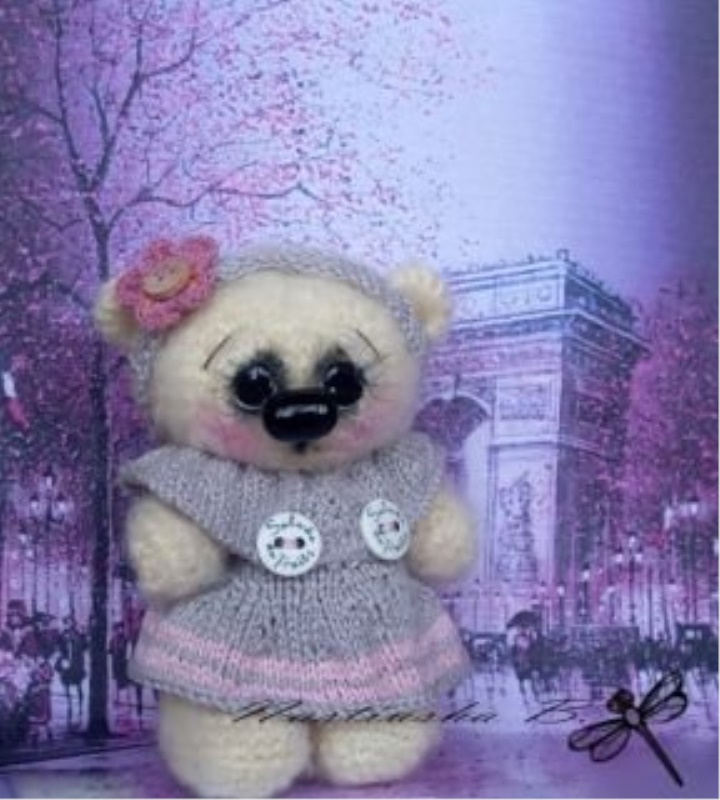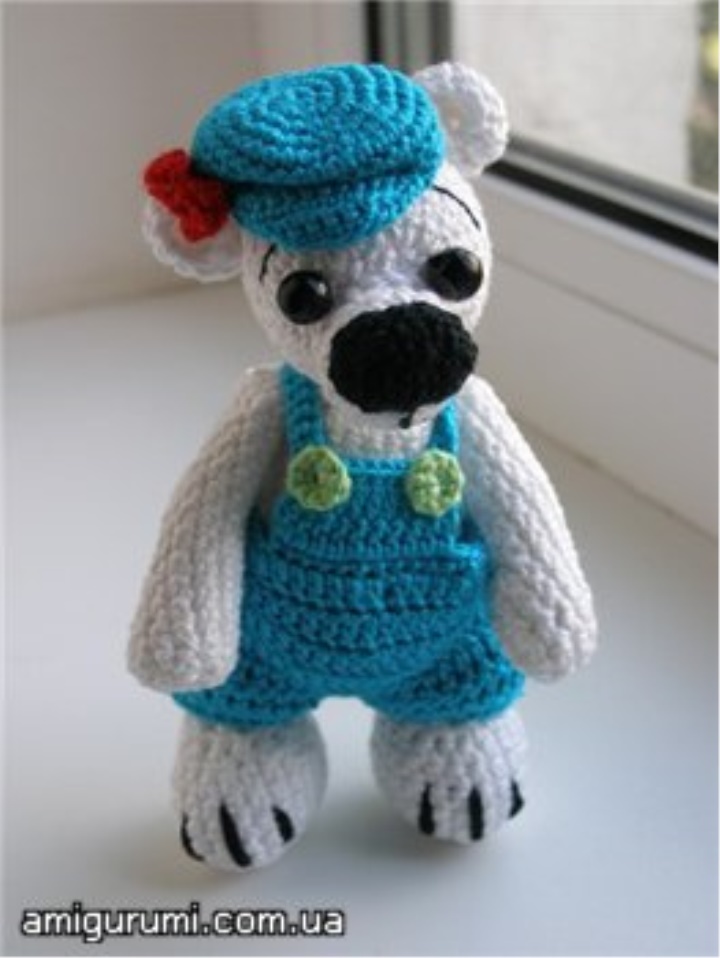
Skirt - bottom (gray and pink)
Knit on 2 needles.Knitting and crochet dress
We type 36 loops in gray (+2 edging)
1 row: 36 facial
2 row: 36 purl
3 row: 36 facial
4 row: 36 purl
5 row: [5 persons, surf] x 6 times = 42
6 row: 42 purl
7 row: [6 persons, prib] x 6 times = 48
8 row: 48 purl
9 row: [3 persons, prib] x 12 times = 60
10 row: 60 purl
11 row: [4 persons, prib] x 12 times = 72
12 row: 72 purl
13 row: [5 persons, surf] x 12 times = 84
14 row: 84 purl
15 row: 84 facial pink
16 row: 84 purl in pink color
17 row: 84 face gray
18 row: 84 purl in pink color
19 row: 84 facial pink
20 row: 84 purl in gray
21 row: close all loops.
• skirt neatly sew in the back;
• Then we sew the upper part to the skirt (not around the whole circumference, but only on the back); buttonholes (at the top) should be in the middle in front;
• We sew to the skirt suitable buttons
• In the eyelets of the neck of the dress we insert a thread of the same color as the yarn for the dress; then already on the toy the neck is a little bit inferior - thus the dress will sit “on a figure”.
• In addition to the dress, you can tie, for example, a headband: we knit 4 rows with 2 or 4 knitting needles with an elastic band - 3 persons, 3 w, 3 persons, 3 w, etc. You can decorate the dressing with a flower: hook a chain of two runners, 6 hooks into the second loop from the hook, into one loop of the previous row: [1cc, 1cbn, 2 cn, 1 cbn, 1cc] - and so we knit all the petals. In the center you can sew a button.

Such clothes suit any toy. However, it is worth remembering that if you knit shorts for a small bear (up to 10 cm), then he can no longer sit in them. Although worth a try!
For very tiny amigurumi, take a toffee in one thread. For more toys - in two. Type a number of air loops so that you can easily embrace the "waist" of bears or hares. In addition, check whether the legs will crawl into such an opening, because often the girth of the feet of the amigurumi is larger than the girth of the "waist." Should get a little loose. For my toys, I dial 42 air loops and close ss. Do not forget that at the beginning of each row you need to knit lifting loops, since we knit rows, not in a spiral. For a number of sbn - 1 vp, for ssn - 2 loops.
1 row: 42 air loops, ss first.
2 row:
3-6 rows: 42 ssn
Next, count 21 loops (divide the canvas in half), type 2vp and join the 21st loop of the ss. We knit 2 vp lifting and knit the first leg in a circle on the ssn. Knit 2-3 rows depending on the size of the toy. The last row can be knit in "stride step".
Similarly, we knit the second leg, attaching the thread to the canvas ss.
Do not forget to fasten the ends so as not to bloom.
On the belt of the shorts, we determine the middle and count 6 loops in different directions from it. Those. the result will be 12-13 loops. It will be a bib. Knit 3-4 rows of ssn.
Next, we knit the straps. To do this, we first collect 28 vp, then the 29th we join the beginning of the bib and knit it to the end of the row and again 28 vp. Back knit sbn to the end. Thus, the straps never get off. You can link colored buttons (2 VP, 8 sbn to the second loop from the hook). Or sew beads and small buttons. It turns out very nice!
And this description from here
Knit elegant dress
The principle of knitting such a dress is very simple. The main thing is to choose the thread and the number of loops to the size of the toy. For example, on a crumb, growing up to 9 cm, it is better to knit with a thin iris in one thread, gaining initially only 19 loops. If the amigurumi is larger - 14-15 cm, then you can knit in two threads or type 28 loops. Bottom knit with your own pattern. If you want a flared dress, then starting from the 11th row, you can make an increase in each loop (so the bottom will turn out wavy). If you need a regular sundress, slightly flared to the bottom, we increase it through two loops. Below is a diagram of a dress on a miniature bear, 9 cm in height. We do not forget to make lifting loops - for a number of UHT 1 w, for ssn - 2 w.
We collect 19 VP.
1 row: starting from the second loop from the hook, knitting 18 kn
2 row: * 1 sbn, increase, * 9 times (27)
3 row: no change (27)
4 row: * 2 sbn, increase, * repeat 9 times (36)
5 row: no change (36)
6 row: * 3 sbn, increase, * repeat 9 times (45)
7 row: we divide our flirt conditionally into 3 parts (the two extreme ones will go to the back and sleeves, and the middle one will be ahead). Extreme divide by two more - the actual back and sleeves. Those. 45 divided by 3 = 15, but since 15 is not divided into two, we leave 7 loops for the back and 8 loops for the sleeves (since very often toys have “hands” on the arms) are quite plump). So, we knit: 7 sbn, 8 vp, count 8 loops on the canvas and, starting with the 9th, knit 15 sbn, then again 8 bp, starting with the 9th on the canvas 7 sbn (45)
8 row: 45 sbn
Row 9: here you can make holes for satin ribbons, if the dress is flared - knit three SSNs, VP, skip one loop, then - 2CHS, VP, 2 SSN, VP. To the end of the series. At the end, we knit 3 ssn
10 row: 45 sbn
Next, we make a flared
11 row: two ssn in each loop (90)
12 row: two ssn in each loop (180)
13 row: 1 run, in the third loop from the beginning we knit 1 ssn, 3 vp, 1 ssn in the same loop, vp and again 1 ssn, 3 vp, 1 ssn to the third loop. To the end of the series.
It turns out such a dress, as in the photo from the bear-bride.
If you want a longer and less magnificent one, then starting with the 11th row we knit an increase in ssn through one loop, and we knit not two such rows, but three (depending on the size of the toy).